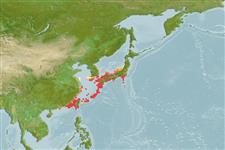分类 / Names
俗名 | 同种异名 | Catalog of Fishes(属, 种) | ITIS | CoL | WoRMS | Cloffa
Teleostei >
Acanthuriformes (Surgeonfishes)
鱸形目 (Surgeonfishes) >
Acanthuridae (Surgeonfishes, tangs, unicornfishes)
刺尾鯛科 (Surgeonfishes, tangs, unicornfishes) > Prionurinae
Etymology: Prionurus: Greek, prion, -onos = saw + Greek, oura = tail (Ref. 45335).
More on author: Valenciennes.
Environment: milieu / climate zone / depth range / distribution range
生态学
海洋 礁区鱼类, usually 2 - 20 m (Ref. 27115). 亞熱帶的; 24°C - 28°C (Ref. 27115)
Northwest Pacific: Matsushima Bay, Japan to Taiwan.
西北太平洋: 日本松島灣到台灣。
大小 / 重量 / 年龄
Maturity: Lm ? range ? - ? cm
Max length : 50.0 cm TL 雄鱼/尚未辨别雌雄; (Ref. 9710)
背棘 (总数): 9; 背的软条 (总数): 22-24; 臀棘 3-4; 臀鳍软条: 21 - 23. Body roundish in young, becoming ovate with age. Forehead without rostral prominence even in adult. Caudal peduncle relatively deep and compressed without dorsal and ventral precaudal depressions. Four or 5 bony plates are on each side of the caudal peduncle. Posterior 3 or 4 plates with feeble triangular keels.
身体圆的当幼鱼时, 变成卵形随着年龄。 甚至在成鱼中前额没有嘴的突起。 尾柄相当深而扁长形的没有背部与腹的尾前椎凹洼。 四或 5个骨质板在尾梗的两边上。 在后部的 3 或 4 碟有薄弱的三角形的龙骨脊。
Often found in groups in shallow, surge rocky areas (Ref. 9710). Anterolateral glandular groove with venom gland (Ref. 57406).
在水浅且有海浪的岩石区中经常被成群发现。 (参考文献 9710) 用毒液腺的前外侧的腺凹槽.(参考文献 57406)
Life cycle and mating behavior
成熟度 | 繁殖 | 产卵场 | 卵 | 孕卵数 | 仔鱼
西北太平洋: 日本松島灣到台灣。
Masuda, H., K. Amaoka, C. Araga, T. Uyeno and T. Yoshino, 1984. The fishes of the Japanese Archipelago. Vol. 1. Tokai University Press, Tokyo, Japan. 437 p. (text). (Ref. 559)
人类利用
水族馆: 商业性
更多信息
俗名同种异名新陈代谢捕食者生态毒物学繁殖成熟度产卵场产卵群集孕卵数卵卵的发育
参考文献养殖养殖信息品种遗传学Electrophoreses遗传率疾病加工NutrientsMass conversion
合作者照片Stamps, Coins Misc.声音神经毒速度泳型鳃区Otoliths脑重体重比眼睛色素
工具
特别资料
下载 XML
网络资源
Estimates based on models
Preferred temperature (Ref.
123201): 17.7 - 26.6, mean 22.5 °C (based on 96 cells).
Phylogenetic diversity index (Ref.
82804): PD
50 = 0.5078 [Uniqueness, from 0.5 = low to 2.0 = high].
Bayesian length-weight: a=0.01995 (0.00906 - 0.04395), b=3.01 (2.83 - 3.19), in cm total length, based on all LWR estimates for this body shape (Ref.
93245).
营养阶层 (Ref.
69278): 2.0 ±0.00 se; based on food items.
回复力 (Ref.
120179): 中等的, 族群倍增时间最少 1.4 - 4.4年 (Preliminary K or Fecundity.).
Fishing Vulnerability (Ref.
59153): Moderate vulnerability (40 of 100).
Nutrients (Ref.
124155): Calcium = 25.2 [12.1, 50.0] mg/100g; Iron = 0.543 [0.277, 1.082] mg/100g; Protein = 18.9 [17.6, 20.3] %; Omega3 = 0.14 [0.08, 0.27] g/100g; Selenium = 16.5 [7.0, 36.4] μg/100g; VitaminA = 20.8 [4.3, 95.1] μg/100g; Zinc = 0.86 [0.53, 1.42] mg/100g (wet weight);
